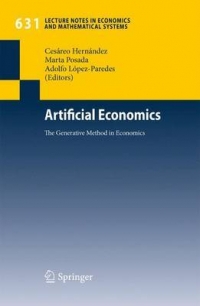Reviewed by
Wolfgang Radax
Vienna University of Technology
 Artificial Economics: The Generative Method in Economics represents the proceedings of the Artificial Economics Conference 2009 which took place in Valladolid, Spain. The book collects all 21 conference contributions (unfortunately excluding the two invited talks) and organizes them evenly spread in seven parts called Macroeconomics, Industrial Organization, Market Dynamics and Auctions, Finance, Financial Markets, Information and Learning, and Methodological Issues, respectively. Given the breadth of topics covered - from Auction Theory to labor markets and even the obligatory Prisoner's Dilemma model - there's certainly something to be found for everybody with an interest in Agent-Based Modeling in economics. The majority of articles is in some way or another concerned with issues related to financial markets. Given the urgency of theory advancement in face of the ongoing economic malaise this focus can only be welcomed and documents the relevance and up-to-dateness of the book.
Artificial Economics: The Generative Method in Economics represents the proceedings of the Artificial Economics Conference 2009 which took place in Valladolid, Spain. The book collects all 21 conference contributions (unfortunately excluding the two invited talks) and organizes them evenly spread in seven parts called Macroeconomics, Industrial Organization, Market Dynamics and Auctions, Finance, Financial Markets, Information and Learning, and Methodological Issues, respectively. Given the breadth of topics covered - from Auction Theory to labor markets and even the obligatory Prisoner's Dilemma model - there's certainly something to be found for everybody with an interest in Agent-Based Modeling in economics. The majority of articles is in some way or another concerned with issues related to financial markets. Given the urgency of theory advancement in face of the ongoing economic malaise this focus can only be welcomed and documents the relevance and up-to-dateness of the book.Without the intention of diminishing the value of the other contributions, I would like to briefly highlight a few works I particularly enjoyed. The first part on Macroeconomics opens with an investigation conducted by Gianfranco Giulioni on potentially adverse effects of a low interest rate policy on macroeconomic performance. The immediate relevance of this effort with respect to the current global economic situation is apparent. And although at the moment the model includes only a single bank lending to firms, it already provides interesting clues to possible side effects of an expansive monetary policy in times of recession.
Chapter 2 by Giulia Canzian, Edoardo Gaffeo and Roberto Tamborini is a highly original amalgamation of ABM and traditional equation-based macroeconomic modeling which could as well be dubbed "Putting Keynes back into the IS-LM Model". Instead of assuming fixed parameters for the parts of the model originally related to psychological motives in the General Theory, these parameters are derived bottom-up from an interaction process between optimistic and pessimistic agents and then fed back into the model equations. Although the model is at a rather preliminary stage as the authors confess, it is capable of reproducing a number of regularities well-known from the empirical literature.
Chapter 9 examines the role of social networks in influencing boundedly rational customers' purchasing decisions in markets where (again boundedly rational) companies may obfuscate prices. Within this setting, Maciej Latek and Bogumil Kaminski investigate the efficiency of regulatory interventions aiming to enhance social welfare. It turns out that the most preferable intervention is the provision of additional information sources to the customers rather than to impose constraints on the companies.
Summarizing, I can only emphasize that I have enjoyed reading the contributions to this volume. The book may lack a clear topical focus but this is only to be expected from proceedings of a conference with a rather broad theoretical agenda. Therefore, I wouldn't consider this a deficit. The individual papers may lack the editorial polish of a journal article or a handbook chapter which is probably owed to the fact that the book was published so soon after the conference, but this doesn't affect the value of the individual contributions.
This volume is an impressive snapshot of the current state of the art in Agent-Based Computational Economics and host to a lot of fresh ideas, a great number of which, to be sure, have work-in-progress status. Nevertheless, each contribution is capable of generating fruitful discussion and offering points of departure for a reader in search of promising research topics related to ABM in economics, making this book a pleasure to read.
Let me conclude this review with a few words of terminological nitpicking. According to the book's preface, Artificial Economics (AE) "can be thought of, as a bridging discipline between Economics and Agent Based Modelling (ABM) and Distributed Artificial Intelligence (DAI). [...] AE should not be considered a chapter of Computational Economics, the main difference being the bottom-up approach of ABM and the generative nature of the method". Rather, AE is seen as "a generative approach to Economics. The purpose of AE is to grow explanations and when there exist, to generate the equilibriums, not just assuming their existence to force the economic models".
I agree with the authors' description but I don't see any additional value in introducing a terminus where there is already an accepted one: Agent-Based Computational Economics (ACE). Although the above description is compatible with definitions of ACE, Artificial Economics should not to be considered a sub discipline of Computational Economics. Agent-Based Computational Economics, however, obviously encourages this categorization as is already made clear, for instance, simply by its name or by the field's handbook which, in fact, is the second volume of the Handbook of Computational Economics (Tesfatsion and Judd 2006). To avoid any further Babylonian confusion about the terms used, I suggest to simply view this book as a further contribution to the field of ACE and, judged by these standards, it is indeed a stimulating contribution.
Return to Contents
of this issue
© Copyright Journal of Artificial Societies and Social Simulation, 2010